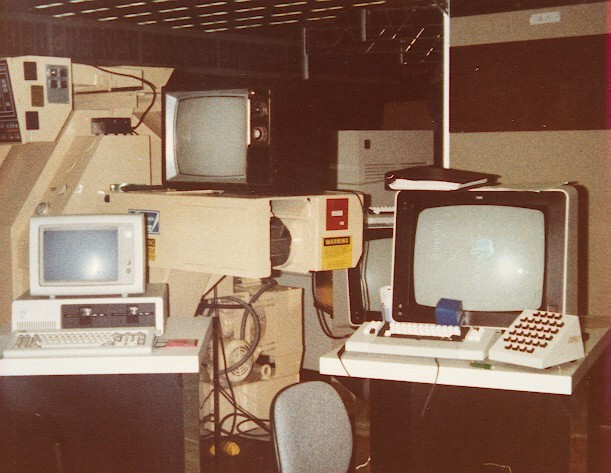This was taken at the "Autofact" trade show about 1982 in Chicago. At the right is
a 3250 graphics display - this was a vector based unit primarily used for CAD/CAM
software, CATIA in this case. The successor to the 3250 (the 5080) was shown for
the first time at this event. We had two machine tools in the booth so we could show
the NC programming capabilities of the software, a Cincinnati lathe (part of which
you see here) and a BostoMatic five axis machining center. The demo part I created
for the BostoMatic was the blue thing sitting on the 3250 keyboard and was a light
pen holder. This was a bit awkward, I suppose, since the 5080 didn't offer a light
pen at the time. We machined these at the show on the BostoMatic. I designed it on
the airplane on the way, and programmed it at the show itself. Very high risk but
it worked out ok. It had small half-spheres on the sides that were inspired by the
peach dessert provided by American Airlines.
The 3250 had a regular keyboard plus a 32 key function keyboard that was programmable.
The program assigned each key a meaning and could light them for operator guidance.
The light pen was used to select geometry on the screen and is shown to the left
of the keyboard. (I'm left handed - most people put the function keys on the left
and the pen on the right.) The 3250 was monochrome only. The 3250 displays (and the
2250's before them) drew their pictures using vectors. Rather than a scanning beam
like a raster display, it had a single beam that traced the picture on the screen.
The host program would send a stream of orders to the 3258 controller - these amounted
to a program that drew the picture. If the graphics were complicated, it took so
long to draw that the screen would flicker madly. If it was really complicated, you
could actually hear it. A great terminal though - very fast for drafting.
To the left is a regular PC with 2 5.25 inch floppy drives and no hard drive. The
thing near the middle that looks like a television set is in fact a television set.
It was used so that people could see what the lathe was doing when the covers were
closed.
